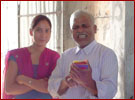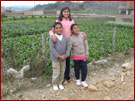
|
|
Situation of children and women in Nepal 2006 THE INFANT For the child that survives its first month, the following 11 months are likely to offer a number of challenges. Most deaths are the result of diarrhoea and/or acute respiratory infections. These conditions are usually exacerbated by underlying malnutrition, and poor standards of care and environmental hygiene. A little less than a third of deaths among children under five years occur during this period . Malnutrition is a serious problem in Nepal, and many children are undernourished from an early age. The early introduction of water and foods increases the risk of infections and thus contributes to malnutrition. By four months of age just over half of Nepali children are exclusively breastfed . By six months of age, one in five children are both too short and thin for their age. The extremely low energy and nutrient content of the typical porridge fed to infants and inadequate frequency of feeding also contribute to malnutrition. By 12 months of age, over half of all children are underweight, and more than one in three is short for their age . Other nutritional problems that affect infants in Nepal include anaemia and vitamin A deficiency. Anaemia (iron deficiency) is by far the most common, impairing the physical and mental development of many children. It affects nine out of 10 children aged 6-11 months [2]. Vitamin A deficiency can make children more susceptible to the effects of diarrhoea, acute respiratory infections and measles. It can also lead to blindness. In 1998, four in 10 children aged 6-11 months suffered from vitamin A deficiency [2]. Nepal has a National Vitamin A Programme that distributes high-dose vitamin A capsules to children aged 6-60 months twice a year. As infants begin to move around and explore their surroundings, they become more prone to infections, and both diarrhoea and acute respiratory infections are more common in children aged 6-11 months than in any other age group. For children who are malnourished and suffering from micronutrient deficiencies, the impact of contracting a common diarrhoeal or respiratory infection can be extremely severe, even fatal, particularly for this age group. The prevalence of diarrhoea is 35 per cent among children aged 6-11 months . However, the increasing coverage of safe drinking water and improved personal hygiene, the availability and proper use of oral rehydration solution, and improved care of children suffering from diarrhoea has reduced its incidence from 3.3 episodes per child per year in 1990 to 1.7 episodes per child per year in 2002 [9]. The incidence of acute respiratory infection is over 36 per cent for children aged 6-11 months . Fatalities are decreasing, as community health personnel in growing numbers are trained to diagnose early pneumonia correctly and treat or refer cases accordingly. The incidence is increasing; however, this may simply mean that reporting is improving. Another threat faced by children in Nepal comes from vaccine-preventable diseases such as measles, tetanus and polio. Nepal has a strong programme of vaccination, with a full course of routine immunization being offered to all children during their first year. Coverage had risen to about 60 per cent by 2001 . National immunization days (NIDs) have been held twice a year since 1996 and have helped maintain polio immunization coverage at over 90 per cent . An important factor in whether common childhood illnesses become life-threatening to the individual child is the family's-and particularly the mother's-knowledge of appropriate care and healthcare-seeking behaviour. Many mothers do not recognize the early danger signs of childhood illnesses. Even if they do recognize such signs, the distance to a point of service, the cost of such a service, and its level of quality also inhibit many families from making use of available healthcare options. Only about one in five children with either diarrhoea or a 'cough/cold' are taken to a healthcare provider . Birth registration is far from universal in Nepal, with only a fifth of children registered before their first birthday [9]. The government guideline is to register all children within 35 days of birth. About one in 15 children born in Nepal will not survive until his/her first birthday . THE PRESCHOOL CHILD Common diseases such as diarrhoea and acute respiratory infection also cause death among children aged one to five years. Malnutrition remains a key underlying factor. Other main causes are malaria, kala azar, and accidents. Almost one third of deaths among children under five years occur during this period . By their fifth birthday, nearly two-thirds of Nepali children are too short for their age . Anaemia affected about three-quarters of under-fives in 1998 [2]. However, the deworming of preschool children since 1999 is expected to have had a significant impact on these levels. Diarrhoea prevalence falls as children grow older from about 30 per cent for one year olds to 10 per cent for four year olds . However, it still causes a large proportion of deaths in this age group, particularly of malnourished children. Acute respiratory infection is apparent in about 28 per cent of two year olds and about 15 per cent of five years olds . Pneumonia is estimated to cause up to one-third of deaths in children aged less than five years . Worms are also a problem, with about four in 10 under-fives having debilitating infestations [10]. One of the main reasons for the chronic poor health of many children is the harmful sanitary conditions that they encounter in their homes and immediate surroundings. Although the vast majority of households has ready access to a water supply, not all water can be considered safe. Over half of tested water is microbiologically contaminated . In addition, many water sources in the terai test positive for arsenic. Furthermore, Dalit households and other disadvantaged groups may face problems with accessing water from a common source due to discrimination. Open defecation is common in Nepal, often making areas around settlements quite unsanitary. Over the years, Nepal has focused on extending the safe disposal of excreta. By 2002, toilet coverage had risen to 27 per cent . However, most households with toilets are in urban areas. Alongside the provision of adequate water supplies and sanitary toilet facilities, households and communities must engage in proper hygiene practices to protect their health. The use of soap and water to wash hands after defecation and before eating is far from universal, particularly for young children. THE LIFECYCLE PERSPECTIVE The care of young children is considered to be primarily the mother's responsibility, often helped by older siblings. Fathers' involvement in young childcare is very limited. Care during the period between the first and fifth birthday is critical for a child's psycho-social development, such as emotional, cognitive, sensory-motor, linguistic and social developments. This requires that the child feels loved and secure, and receives various kinds of stimulation, response and attention. Awareness about the importance of early child development is very low in Nepal, and opportunities are limited for child caretakers to learn about basic skills for good parenting. There seems to be a general feeling that child development happens on its own, and many preschool children in Nepal, particularly in rural areas, are left alone or in the care of siblings for long periods of time while their mothers work. Parenting orientation classes are run in communities to increase awareness about early childhood development. They also seek to increase fathers' participation in childcare. Community-based child development centres have been established in some areas to provide children with developmentally appropriate stimulation and places to socialize. These centres also give mothers and older siblings greater freedom to pursue activities besides childcare. Among all children born in Nepal, about one in 11 dies before reaching his/her fifth birthday . The material for this page is from www.un.org.np/reports/UNICEF/2006/situation-analysis/conver-page.pdf
|




